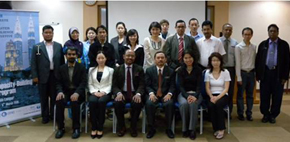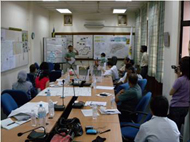Events
Climate and Disaster Resilience Initiative (CDRI) Capacity-building Program Stage 2: Training Workshop in Kuala Lumpur
Date: March 3 - 5, 2010
Venue:Kuala Lumpur
Organized by:
- Kyoto University Graduate School of Global Environmental Studies (under the Global COE Program of “Human Security Engineering in Asian Megacities”)
- CITYNET (Regional Network of Local Authorities for the Management of Human Settlements)
- Tokyo Distance Learning Center (TDLC) of the World Bank (Global Development Learning Network)
- United Nations International Strategy for Disaster Reduction (UNISDR)
- Sustainable Environment and Ecological Development Society (SEEDS)
Asia Regional Task Force on Urban Risk Reduction (RTF-URR)
Number of attendants : 16
Outline
OVERVIEW
The CDRI Capacity-building Program is designed to help city government officials become further aware and be able to communicate more easily on the current and potential future risks which their cities face. The program is divided into 3 stages:
- Stage 1: Capacity-building of city government officials, to complete a CDRI Questionnaire for the creation of overall resilience mapping
- Stage 2: Training and Action Workshop, to design a self-evaluation matrix and to initiate Climate Action Planning
- Stage 3: Initiating development of the Climate Action Planning (CAP) and implementation process
As a blended program, the CDRI Capacity-building Program has the following components: online distance learning via Moodle (Modular Object-Oriented Dynamic Learning Environment), video conference, and face-to-face training workshop. The Moodle site became accessible to the participants starting February 5 while four video conferences are planned to be conducted throughout the duration of the program.
The face-to-face training workshop was held in Kuala Lumpur on March 3-5, 2010, with the following objectives:
- With the overall resilience mapping, to review urban resilience, including development of measuring tools, i.e. CDRI
- To come up with measurable implementation measures, i.e. self-evaluation matrix, and
- To discuss required actions within time frames through demonstration of a methodological approach for facilitating the creation of the CAP.
SUMMARY OF WORKSHOP PROCEEDING
The training workshop was attended by 16 participants: 1 each from the 8 participating cities (Chennai, India; Colombo, Sri Lanka; Dhaka, Bangladesh; Hue, Vietnam; Kuala Lumpur, Malaysia; Makati, Philippines; Sukabumi, Indonesia; and Suwon, South Korea) and 8 in all from the organizing institutions: Kyoto University Graduate School of Global Environmental Studies (under the Global COE Program of “Human Security Engineering in Asian Megacities”), CITYNET (Regional Network of Local Authorities for the Management of Human Settlements), Tokyo Distance Learning Center (TDLC) of the World Bank (Global Development Learning Network), United Nations International Strategy for Disaster Reduction (UNISDR), Sustainable Environment and Ecological Development Society (SEEDS), and Asia Regional Task Force on Urban Risk Reduction (RTF-URR).
On the first day, the workshop opened with self-introduction from the participants and sharing of expectations. This was followed by the presentation of the CDRI Analysis Result, the output of Stage 1, and a discussion on its implications to the cities. In the succeeding sessions on the second day the participants actively took part in several activities designed to demonstrate how the cities can develop time-framed specific action plan to enhance their urban resilience. A discussion on the future steps in the CDRI Capacity-building Program was made to keep everyone on track and ensure that the objectives of the program are met. The last activity on the third day was town-watching in Kampong Baharu, the only remaining traditional village in Kuala Lumpur.
At the end of the training workshop, the participants were able to submit 4 individual outputs (Self-evaluation Matrix, Climate Action Plan, HFA Priorities, and Stage 2 Evaluation) and 3 group outputs (HFA-Stakeholders Matrix, HFA-CDRI Linkage, and Town-Watching SWOT Analysis). The outputs were immediately uploaded to the Moodle site for sharing with other participants.
Report
MAJOR DISCUSSION POINTS
During the course of the training workshop, several important issues were raised and discussed:
- Difference between CDRI and HFA
The language of the CDRI and HFA are different. The HFA is a low-resolution guidance document. It was designed to be generic and not include too much detail to make it easy for all UN member states to adopt. On the other hand, the CDRI is a high-resolution document. It has more details and contains 125 specific indicators. The two documents can be used simultaneously to effectively address urban resilience issues.
- Funding for the specific actions identified during the Climate Action Planning (CAP)
The beauty of the entire exercise is that the city has ownership of the projects that they will implement. So the cities are encouraged to implement activities that are self-financed. Pursuing external funding from donors might take time. One suggestion is for the cities to integrate their activities in existing development projects.
- Monitoring and Evaluation (M&E) indicators
To be effective, there should be objective measurements of the impacts of the activities performed by the cities. But as the cities are very different from each other, the cities should each develop their own set of qualitative and quantitative M&E indicators. What the program organizers will do is to assist the cities in terms of reviewing the indicators the cities will come up with and providing comments and suggestions.
- Knowledge and experience sharing between the participating cities and organizers
To facilitate the sharing of information and good practices between the participating cities and organizing institutions, it was proposed that a mechanism or platform be established. This can be an e-group (Yahoogroup), a social medium (Facebook), or a new feature in Moodle (discussion forum or chat).
- Participation in UNISDR’s new campaign
The participants, together with their colleagues back home, were encouraged to plan effective, innovative, feasible activities in Stage 3 of the program and successfully implement their action plans as soon as possible. It is hoped that the participating cities in the Kuala Lumpur workshop can be nominated and eventually chosen as role model cities in UNISDR’s 2010-2011 World Disaster Reduction Campaign “Making Cities Resilient”.
- Common schedule for the succeeding activities
It is very important that the participants attend all video conferences and submit all expected outputs in Stage 3 on time. The participants were advised to sound off if they foresee any conflict in the schedule of the next video conferences (e.g., long holidays in South Asia in April).
The most important thing emphasized in the Kuala Lumpur workshop was that now is the time to convert plans into action. One or two small concrete actions started immediately can help propel the cities into taking bigger actions in climate urban resilience enhancement in the future.



